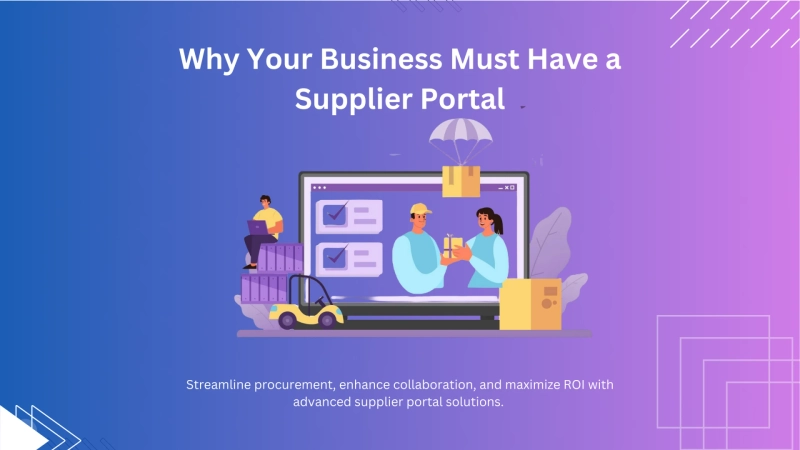In today’s fast-paced business world, efficiency and transparency are critical to maintaining a competitive edge. Managing suppliers effectively is a cornerstone of operational success, and this is where a supplier portal solution becomes indispensable. If you’re asking yourself, Why your business needs a supplier portal? this guide will provide a comprehensive overview of its importance and implementation.
What is a Supplier Portal?
A supplier portal is a secure online platform where businesses and their suppliers can interact, share information, and manage transactions. It serves as a central hub for activities such as purchase orders, invoice processing, performance tracking, and communication.
Modern supplier portals leverage cloud technology, automation, and analytics to streamline operations, reduce errors, and enhance collaboration between businesses and their suppliers.
Why Your Business Needs a Supplier Portal
1. Streamlined Operations
A supplier portal eliminates manual processes like handling paperwork, emails, and phone calls. Suppliers can access real-time information about orders, invoices, and payments, ensuring smooth and efficient operations.
2. Improved Communication
One of the most significant challenges businesses face is maintaining clear communication with suppliers. A supplier portal centralizes all interactions, allowing instant updates, notifications, and status tracking.
3. Enhanced Supplier Performance
Supplier portals often include performance metrics, enabling businesses to monitor supplier reliability, delivery timelines, and quality standards. This insight fosters accountability and helps identify areas for improvement.
4. Cost Savings
By automating routine tasks and reducing manual errors, businesses save time and resources. The portal also minimizes delays, ensuring better cash flow and operational efficiency.
5. Transparency and Compliance
Supplier portals provide a clear record of transactions and communications. This transparency helps ensure compliance with regulations and standards, reducing risks associated with audits or disputes.
6. Scalability
As your business grows, managing more suppliers can become overwhelming. A supplier portal provides scalable solutions to handle a larger network without compromising efficiency or quality.
Key Features of a Supplier Portal
A robust supplier portal should include:
User-Friendly Dashboard
- Easy navigation and access to key information for both businesses and suppliers.
Real-Time Updates
- Instant notifications for order changes, payments, or other critical updates.
Document Management
- Secure upload and storage of contracts, invoices, and compliance documents.
Performance Tracking
- Analytics to measure supplier performance and identify trends.
Integration Capabilities
- Seamless integration with existing ERP and procurement systems.
Self-Service Options
- Empower suppliers to resolve queries independently, such as checking order statuses or payment details.
How to Implement a Supplier Portal
1. Assess Your Needs
Evaluate your business requirements and identify pain points in supplier management. This will help you determine the features you need in a supplier portal.
2. Choose the Right Platform
Select a supplier portal that aligns with your business goals and integrates with your existing systems. Popular platforms include SAP Ariba, Coupa, and Oracle Supplier Portal.
3. Onboard Your Suppliers
Provide training and support to ensure your suppliers can use the portal effectively. Share guides, conduct webinars, and offer ongoing assistance.
4. Integrate with Current Systems
Ensure the portal integrates smoothly with your existing tools like ERP, CRM, or accounting software for seamless data flow.
5. Monitor and Optimize
Regularly track portal usage and gather feedback from suppliers. Use this information to optimize features and processes for better results.
Benefits of a Supplier Portal for Suppliers
While supplier portals primarily benefit businesses, they also offer significant advantages to suppliers:
- Faster invoice processing and payments.
- Transparency in order statuses and delivery schedules.
- Reduced administrative workload through self-service tools.
- Enhanced collaboration with businesses.
Real-World Examples
Example 1: Amazon Vendor Central
Amazon’s supplier portal streamlines order management, invoicing, and performance tracking for its vendors, ensuring smooth operations at scale.
Example 2: Unilever Supplier Portal
Unilever uses its supplier portal to promote sustainability, improve transparency, and strengthen supplier relationships across its global network.
Conclusion
A supplier portal is no longer a luxury but a necessity for businesses aiming to improve efficiency, transparency, and supplier relationships. By centralizing processes, automating tasks, and fostering collaboration, it drives operational excellence and scalability.
So, why does your business need a supplier portal? The answer lies in the ability to save time, reduce costs, and build stronger supplier partnerships—all of which are critical to thriving in today’s competitive marketplace.
Invest in a supplier portal today and empower your business for success tomorrow.


